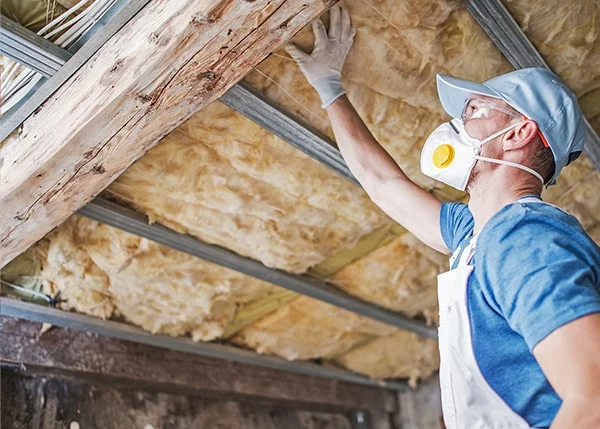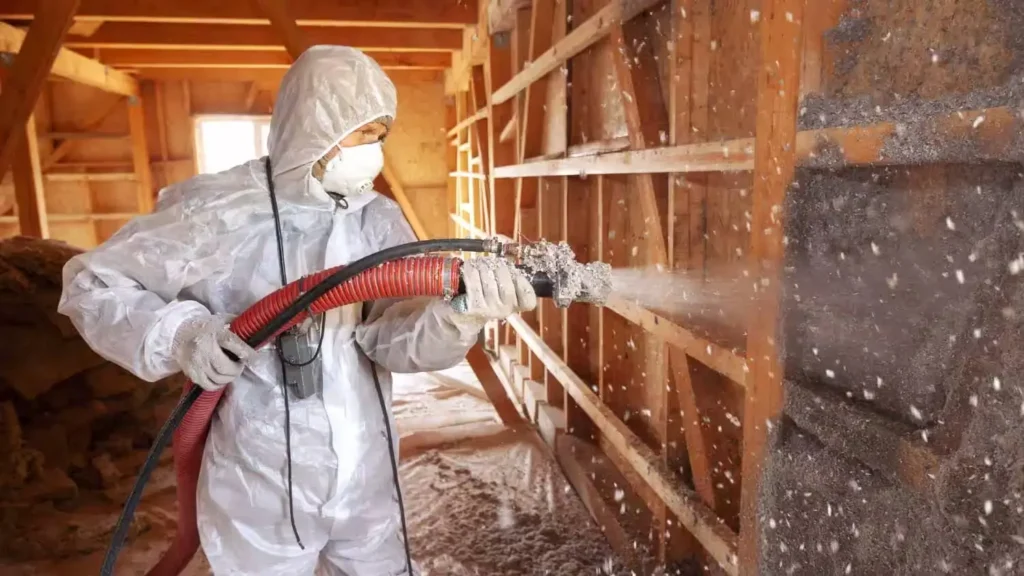Fast, Dependable Results when it Matters the Most
How to Identify Asbestos Insulation in Walls & Attics
Exploring the topic of identifying asbestos insulation in walls and attics, we uncover that approximately 80% of homes built before 1980 may contain asbestos materials.
Understanding the potential risks posed by asbestos exposure is essential for safeguarding our well-being and property.
By unraveling the intricacies of identifying asbestos insulation, we equip ourselves with the necessary tools to protect our homes and loved ones.
Stay tuned to discover practical tips and key insights on recognizing and addressing asbestos-containing materials effectively in your living environment.
Key Takeaways
- Professional inspection is crucial for identifying asbestos insulation safely.
- Asbestos insulation can be found in various home locations susceptible to heat transfer.
- Testing is necessary to confirm the presence of asbestos in insulation.
- Damaged insulation suspected of containing asbestos should not be disturbed.
What Is Asbestos Insulation?

What exactly characterizes asbestos insulation, and why is it important to identify in homes?
Asbestos insulation refers to insulation materials that contain asbestos, a mineral known for its heat resistance. This type of insulation was commonly used in older homes due to its effectiveness in reducing heat transfer. Asbestos insulation can be found in various forms such as blanket, block, loose-fill, and spray-on insulation. It has a distinctive cotton-like appearance and structure, making it identifiable upon visual inspection.
Identifying asbestos in insulation is important because inhaling asbestos fibers can lead to serious health issues like lung cancer, mesothelioma, and asbestosis. Long-term exposure to asbestos can have severe consequences, and hence, it’s essential to determine whether asbestos is present in insulation to ensure the safety of occupants. Testing for the presence of asbestos in insulation is necessary to take appropriate precautions and prevent potential health risks associated with asbestos exposure.
Why Is Asbestos Insulation Dangerous?

Exposure to asbestos insulation poses significant health risks due to the potential inhalation of asbestos fibers, leading to severe respiratory conditions. Asbestos fibers, when disturbed, can become airborne and easily inhaled, causing serious health issues such as coughing, breathing difficulties, chest pain, and more severe conditions like Mesothelioma and Asbestosis.
Long-term exposure to asbestos can result in delayed onset health problems, including lung cancer. Identifying asbestos insulation is important to avoid health risks associated with handling it. Knowing safe insulation types like batt or blanket insulation, loose-fill fiberglass insulation, cellulose insulation, and rock wool insulation can help differentiate them from asbestos-containing materials.
When dealing with asbestos insulation, it’s essential to avoid disturbing it, test for asbestos presence, consider professional abatement services, adhere to EPA safety guidelines, and take necessary precautions to safeguard health. Proper identification and handling of asbestos insulation are essential steps in preventing exposure and mitigating associated health dangers.
Types of Asbestos Insulation
Asbestos insulation comes in various types, each with distinct characteristics and applications. Blanket insulation is flexible and commonly found in attics and walls. It contrasts with block insulation, consisting of rigid foam panels.
Loose-fill insulation is fluffy and blown into place. Spray-on insulation starts as a liquid that expands and hardens to fill gaps.
Blanket Insulation
Identifying blanket insulation involves recognizing its flexible and commonly used form in attics and walls. Here are four important points to keep in mind when dealing with blanket insulation containing asbestos:
- Visual Identification: Look for a cotton-like appearance and structure, which is characteristic of blanket insulation.
- Health Risks: Understand the potential health hazards associated with asbestos exposure from this type of insulation, including respiratory issues and serious diseases.
- Professional Inspection: Consider engaging experts for a thorough inspection to assess the presence of asbestos accurately.
- Safety Measures: Take precautions to avoid disturbing the insulation and seek professional guidance on proper handling to minimize health risks.
Call Now
You Can Call Us At This Number: 720-399-3335
Block Insulation
Block insulation, a rigid foam panel material commonly used in various structures, presents specific considerations regarding asbestos presence and safety concerns. When identifying asbestos in block insulation, it’s important to be aware that asbestos fibers may be present within the rigid foam panels.
Visually, asbestos-containing block insulation may appear similar to non-asbestos varieties, making it challenging to detect without proper testing. It’s vital to exercise caution when dealing with block insulation suspected of containing asbestos to prevent the release of harmful fibers.
If there are doubts about the presence of asbestos in block insulation, it’s advisable to consult professionals for testing and safe removal. Remember, asbestos in walls or attics can pose serious health risks, so handling it safely is paramount.
Loose-Fill Insulation
When inspecting homes for potential asbestos-containing materials, it’s essential to understand the characteristics of loose-fill insulation commonly found in attics and walls. Loose-fill asbestos insulation can pose serious health risks if disturbed, making proper identification important.
Here are some key points to keep in mind:
- Identification: Loose-fill asbestos insulation appears fluffy and is often blown into place in attics or walls.
- Attics Insulation: Check attics for loose-fill insulation as it’s a common location for asbestos presence.
- Professional Inspection: Hire professionals to inspect and test suspected loose-fill insulation for asbestos content accurately.
- Asbestos Exposure: Any suspicion of loose-fill asbestos should prompt immediate action to prevent potential exposure risks.
Understanding these aspects is essential for safe handling and maintenance of properties with loose-fill asbestos insulation.
Spray-On Insulation
Inspecting loose-fill insulation in homes is important for identifying potential asbestos-containing materials, with spray-on insulation being another common type that warrants attention.
Spray-on insulation, often seen as a thick gray layer on ceilings, can contain asbestos. It’s essential to know what asbestos insulation looks like to differentiate it from safer alternatives like cellulose.
If you’re wondering if a house built in a certain era would have asbestos, homes constructed between 1900 and the 1980s are more likely to contain asbestos materials.
When trying to tell the difference between cellulose and asbestos insulation, remember that cellulose is generally gray loose-fill and is typically asbestos-free when uncontaminated.
Paying attention to these details can help in identifying and managing asbestos insulation safely.
Vermiculite Insulation
Vermiculite insulation, a type of asbestos insulation, is characterized by its loose-fill form and pebble-like appearance, often containing asbestos fibers.
- Familiar Appearance: Its pebble-like look may trigger nostalgia but beware of its hidden dangers.
- Potential Health Risks: The charm fades when considering the health hazards posed by asbestos exposure.
- Removal Challenges: Dealing with vermiculite insulation requires caution and professional expertise.
- Safety First: Prioritize safety by avoiding DIY removal and seeking professional guidance for handling this hazardous material.
Common Places To Find Asbestos Insulation in Your Home
In older homes, asbestos insulation can commonly be found in various areas such as attics, basements, crawl spaces, walls, closets, floors, and ceilings.
Attics often contain asbestos insulation in the form of blanket insulation, which is flexible and can be easily manipulated.
Basements may have block insulation, consisting of rigid foam panels that can release fibers if disturbed.
Crawl spaces might harbor loose-fill insulation, a fluffy material blown into place for insulation.
Walls can contain spray-on insulation, appearing as a thick gray layer on ceilings.
Closets may have wrapped pipe insulation resembling corrugated cardboard.
Floors and ceilings could also hide asbestos-containing materials used for heat resistance.
It’s important to be cautious in these areas and consider testing if there’s a suspicion of asbestos presence, since proper identification is important for managing potential health risks associated with asbestos exposure.
How To Identify Asbestos Insulation Safely
When identifying asbestos insulation safely, it’s important to be cautious in areas where asbestos may be present, such as attics, basements, crawl spaces, walls, closets, floors, and ceilings in older homes.
- Prioritize Professional Inspection: Seek expert evaluation as any level of asbestos exposure is unsafe.
- Avoid Disturbing Suspected Asbestos: Damaged insulation shouldn’t be disturbed to prevent fiber release.
- Thorough Home Assessment: Asbestos might be present beyond insulation, necessitating a thorough inspection.
- Utilize Professional Testing Services: Labs can accurately test insulation samples for asbestos presence, ensuring safety.
Professional handling and testing are vital due to the severe health risks associated with asbestos exposure. Taking precautions and following expert guidance can prevent potential health hazards. Always treat any suspected asbestos-containing material with care and seek professional assistance for safe identification and management.
Frequently Asked Questions
We strongly advise against self-removing asbestos insulation due to health risks. Hiring a professional for safe removal is critical. Protect your health and guarantee proper handling. Asbestos exposure is serious and should only be managed by trained experts.
We can’t recommend DIY tests for detecting asbestos in walls or attics. Professional inspection is essential due to the health risks associated with asbestos exposure. Handling asbestos requires caution and expert guidance to guarantee safety.
Exposure to asbestos insulation can lead to health issues like asbestosis and lung cancer. Symptoms may take years to appear, linking back to past exposure. It’s important to seek professional help to manage potential risks.
There are alternative insulation materials like fiberglass, cellulose, and rock wool that can replace asbestos insulation in older homes. These materials are safe, effective, and commonly used for insulation purposes, providing a suitable substitute for asbestos.
Regulations and laws mandate safe handling and disposal of asbestos insulation in residential properties. Professional inspection and testing are essential due to the severe health risks associated with asbestos exposure. Expert management guarantees safety.
Conclusion
To sum up, identifying asbestos insulation in walls and attics is essential for ensuring a safe living environment.
Just like a detective uncovering clues to solve a mystery, homeowners must carefully inspect their homes for potential asbestos-containing materials.
By understanding the risks associated with asbestos exposure and taking proactive steps to address any concerns, we can protect our loved ones and maintain a healthy home for years to come.
Stay vigilant and informed to safeguard against this hidden danger.

